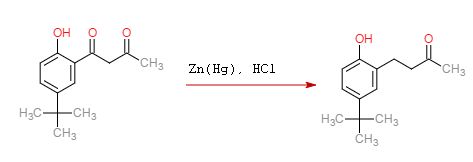A Clemmensen reduction of a 1,3-diketone probably isn't the best idea. The reduction is likely to proceed via a ketyl radical.

In the case of a 1,3-diketone, formation of a dihydroxy cyclopropane, which undergoes opening/rearrangement cannot be excluded.
This reaction has for instance been observed for dimedone, where 2,4,4-trimethyl cyclopentanone was formed.
EDIT 1
Which other viable procedures exist?
If you insist on using the given starting material, the following might (!) work:
regioselective (asymmetric) catalytic hydrogenation of the acetophenone-type carbonyl using a 1,2-diamine-substituted Noyori catalyst
Barton-McCombie reaction of the resulting alcohol
If you are rather interested in the product, you might want to rethink the strategy:
The intended product is an arylbutanone, related to the raspberry ketone. A possible retrosynthesis would be:

If you get your hands on the necessary benzaldehyde, an aldol reaction with acetone, followed by catalytic hydrogenation might give the right product.
EDIT 2
5-tert.-butyl-2-hydroxybenzaldehyde is commerically available, but not really cheap.
However, 4-tert.-butylphenol is cheap as dirt. In case you need significant quantities of your final product, you might want to consider the synthesis of the benzaldehyde. The substitution pattern cries for a Reimer-Tiemann reaction.



